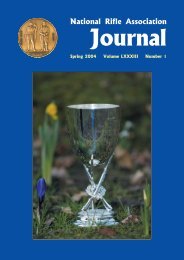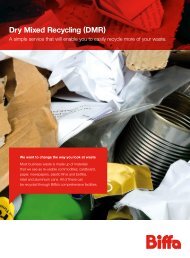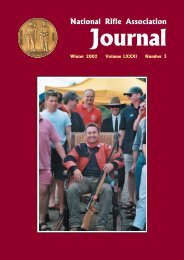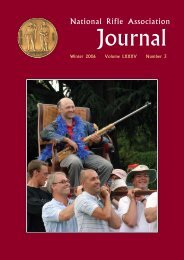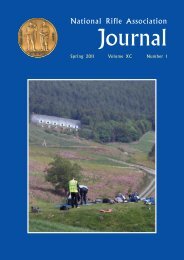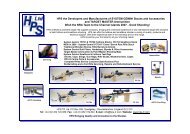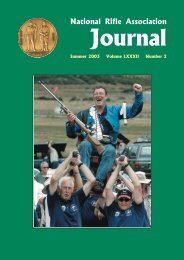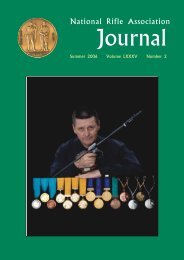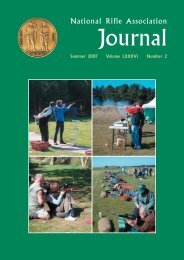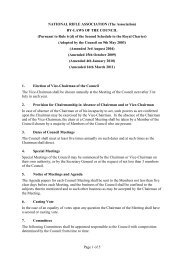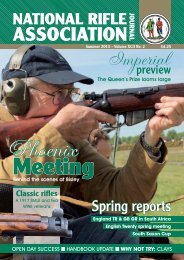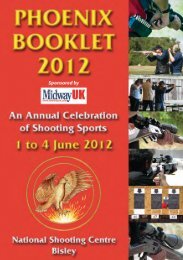NRA Journal - Spring 2007 - National Rifle Association
NRA Journal - Spring 2007 - National Rifle Association
NRA Journal - Spring 2007 - National Rifle Association
- No tags were found...
You also want an ePaper? Increase the reach of your titles
YUMPU automatically turns print PDFs into web optimized ePapers that Google loves.
continued for the following two years. There is nocurrent evidence that the military authorities made useof the tramway and it seems likely that “Wharncliffe”and the tramcars remained in their shed at least until1917 when the Army at Blackdown Camp made arequest to hire the locomotive.The Executive and Finance Committee of the <strong>NRA</strong>met on 23 March 1917 and it was recorded underItem 11 that:The Secretary stated that a verbal application had beenmade by Colonel Fraser, CRE Blackdown, for the hireof our light engine (The “Wharncliffe”) and at rate.The Committee approved of its being hired out andasked Colonel Barlow kindly to ascertain what wouldbe a fair charge.Col Crosse of the <strong>NRA</strong> telephoned Col Fraser and toldhim that the engine was valued at £300 and thereforethe annual charge at 25% would be £75 per annum.A following letter to Col JP Fraser CRE Blackdown,offered the Loco at £6 per month.The military extension of the Bisley Branch toBlackdown and Deepcut had been authorised in 1916and was completed in 1917. In the absence of anyfurther information it is assumed that “Wharncliffe”was required to assist in construction work. There isno confirmation in the records as to whether the hireactually took place.The exchange of letters did, however, give someleading dimensions of “Wharncliffe”. These are listedbelow together with others that have come to light.The <strong>NRA</strong> <strong>Journal</strong>, which had commenced publication in 1903,ran a regular series of articles entitled “Familiar Scenes at Bisley”.Number 3, which appeared in 1911, is believed to show thedriver, Charles Ginman, boarding the tram at the Siberia RangeTerminal.Name and Number“Wharncliffe”, <strong>NRA</strong> Number 1Maker, Type and Works NumberMerryweather and Sons Type 1, Works Number 32(Repaired/rebuilt by L&SWR at Nine Elms 1894)Date constructed 1877Boiler pressure120lbs per sq in(Probably 80psi before installation of new boiler in 1900)New Boiler 1900GaugeMaximum Height to top of CabWidth of cabWeight with water and coalPower Rating3ft 6ins9 feet6ft 6ins4 tonsWheel Arrangement 0-4-0Wheel DiameterLength (Max)Length (of body)Cylinders (bore diameter x stroke)Firebox LengthBoiler Barrel lengthBoiler Barrel diameterabout 7HP2ft8ft 11ins8ft6ins x 9ins2ft 9ins3ftNumber of Flue Tubes 94Flue Tube diameter (outside)Boiler Heating SurfaceTotal Heating Surface2ft 7ins1 ? ins98sq ft132sq ftWhether it was used on the military extension or notthe 1919 Bisley Bible, and later Boiler Reports, confirmthat “Wharncliffe” was not put back into use on therange tramway after the War.The Bisley Bible for the 56 th Annual Meeting 9 July- 19 July 1919, the first to be held after the War ended,stated - ‘Range Tramway - To and from the BisleyCamp Station and Range 23 will not run this year’.This was the last mention of the Tramway to appearin this annual handbook.The last internal boiler inspection was made early in1919 by the <strong>National</strong> Boiler and General InsuranceCompany. After that date the latter wrote annuallyto the <strong>NRA</strong> enquiring whether the boiler could beinspected. The <strong>NRA</strong> Secretary invariably replied thatit was not expected that the boiler would be in usethat year. The last letter of this nature in the recordsis dated 21 February 1922.In 1926 a most interesting Report, dated 17 September,was sent to the <strong>NRA</strong> regarding proposals to put theSiberia Ranges back into use. The implication is thatthey had been out of use probably since early in the42



